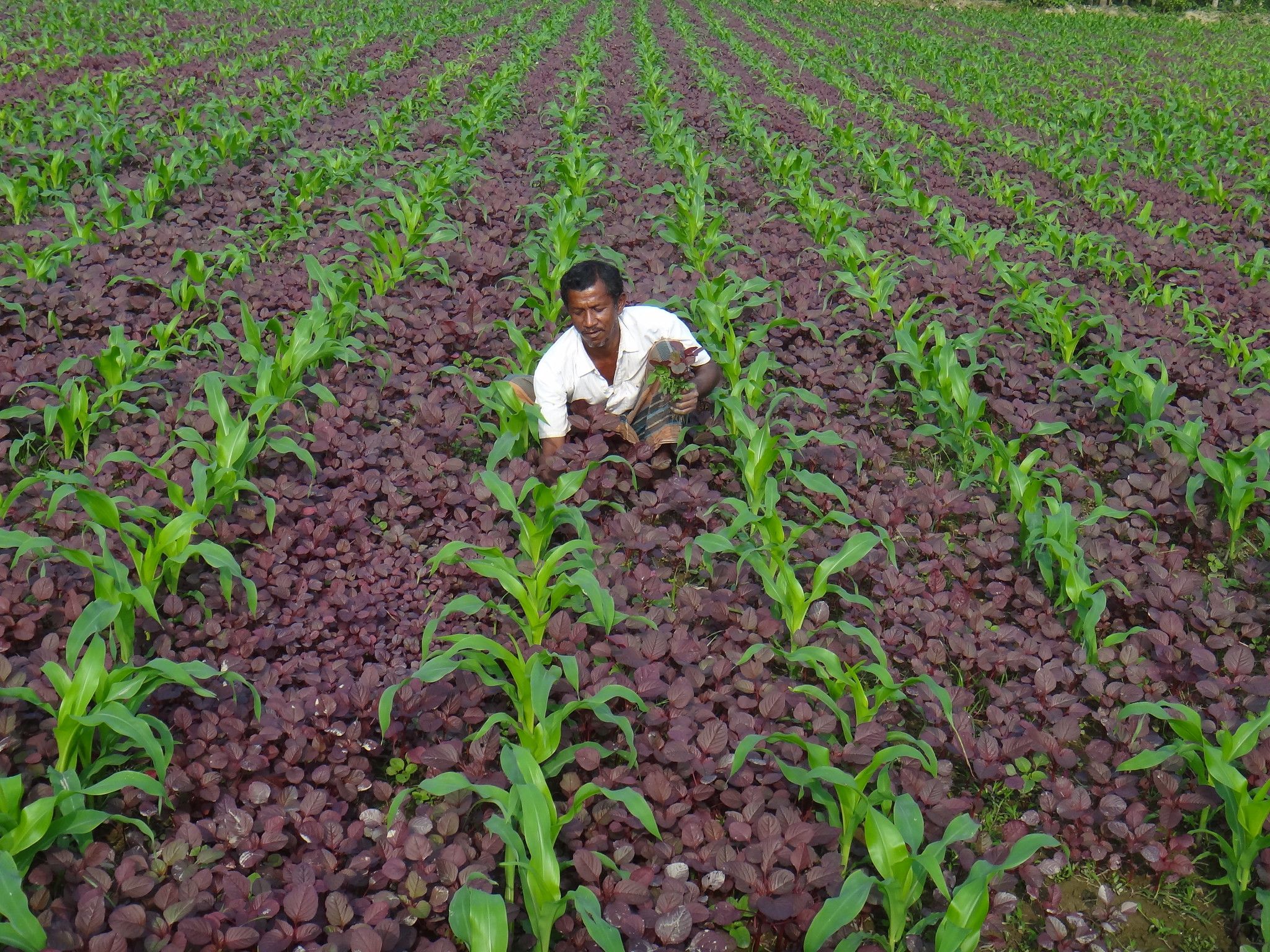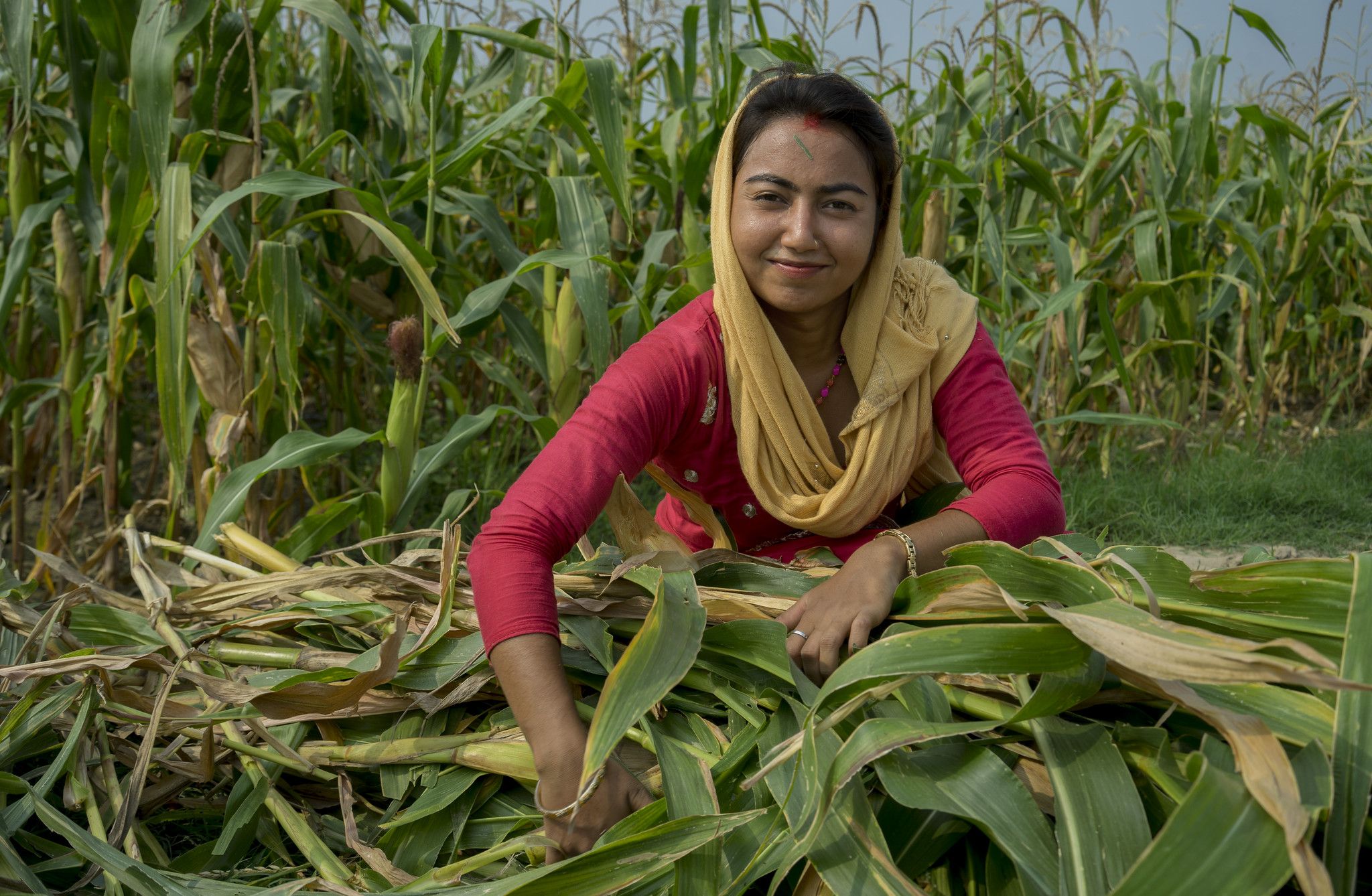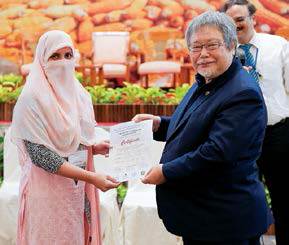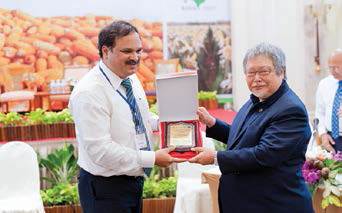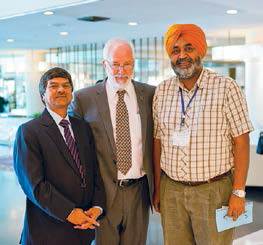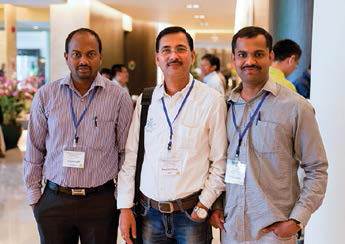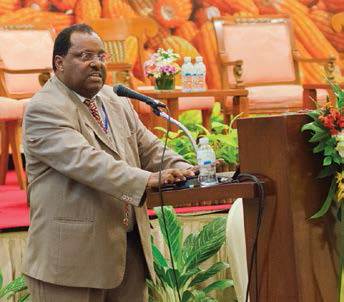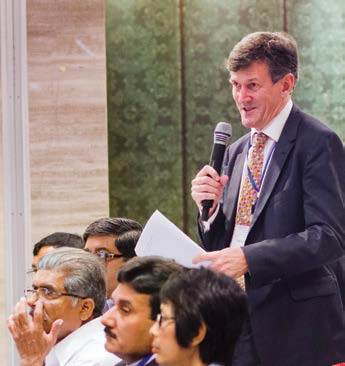Location: Thailand
Improved Maize for Tropical Asia (IMTA)
The Improved Maize for Tropical Asia (IMTA) is employing modern maize breeding techniques to develop and deploy new, climate-resilient maize hybrids, including traits important for identified niche markets across tropical Asia.
Principal Coordinator: B.S. Vivek
Climate Resilient Maize for Asia (CRMA)
Climate Resilient Maize for Asia is supported by Germany’s development agency GIZ, and implemented as a public-private partnership, which targets enhanced resilience among resource-poor, maize-based farming families in South and Southeast Asia by providing them with abiotic stress-tolerant maize hybrids adapted to rain-fed stress-prone production systems for crop diversification, intensification and higher yields.
Most of the maize in Asia is grown as a rain-fed crop, which is prone to vagaries of seasonal monsoon rains. This is clearly reflected in the productivity of maize under rain-fed systems — usually less than half of the irrigated system. The erratic distribution pattern of monsoon rains results in drought or water logging at different crop growth stages, which is the main factor responsible for relatively low productivity of rain-fed maize. Due to the possibility of uncertain economic returns, farmers often hesitate to invest in improved seed, fertilizers and inputs, which further add to poor yields of rain-fed maize. Climate change effects are further threatening an already challenging maize mega-environment in the Asian tropics, which are identified as subject to climate change effects, with high vulnerability and low adoption capacity.
The project deals with high priorities of Asian stakeholders related to improving maize production in the face of current and anticipated effects of climate change and access to diverse and valuable maize germplasm, building upon the GIZ-funded project known as “Abiotic stress tolerant maize for increasing income and food security among the poor in South and Southeast Asia,” where significant progress is being made towards understanding the rain-fed stress-prone agro-ecologies in South and Southeast Asia, development of improved maize germplasm with enhanced levels of tolerance to drought, waterlogging or combined stress tolerance.
OBJECTIVES
- Using data on elevation, aridity index and mean annual rainfall, a climate similarity map with a total 30 zones was developed for South Asia. This is useful in planning regional hybrid trials respective environment analogue.
- New hybrid combinations by crossing promising stress-tolerant lines and evaluated across moisture regimes, including managed drought and waterlogging stresses, and optimal conditions, and a set of 50 promising hybrids are ready for large-scale adaptive trials.
- Among the inbred lines developed under the project, four most promising lines were globally released CML (CIMMYT Maize Lines), namely CML-562, CML-563, CML-564 and CML-565, for use in low-land tropical breeding programs targeting stress-prone rainfed environment.
- Total 18 Quantitative Trait Locus (QTLs) for grain yield under waterlogging and 21 QTLs for grain yield and anthesis-siling interval under drought were identified using genome-wide association studies and analyses of bi-parental populations. These validated genomic regions are candidate for introgression into elite Asia-adapted genetic background.
- Breeder ready marker assays (KASP assays) have been developed for the 18 significant genomic regions that typically explained more than 10 percent of phenotypic variance under water-logging stress.
- Protocol for rapid-cycle genomic selection (RC-GS) optimized with regards to constitution of suitable target population, and suitable statistical model for genomic selection.
- Genetically enhanced cycle (C2) of two multi-parent synthetic populations were developed by inter-mating top 5 percent progenies with high genotypically estimated breeding values (GEBVs) were submitted for subjecting to double haploid for deriving new generation of stress-resilient maize lines
FUNDING INSTITUTIONS
- Germany’s development agency GIZ
PRINCIPAL COORDINATOR
Highlights of the 12th Asian Maize Conference
The 12th Asian Maize Conference and Expert Consultation on “Maize for Food, Feed, Nutrition and Environmental Security” convened in Bangkok, Thailand from 31 October to 1 November 2014.
Organized by the Asia-Pacific Association of Agricultural Research Institutions (APAARI), CIMMYT, the Food and Agriculture Organization (FAO) of the United Nations and the Thai Department of Agriculture (DoA), the Conference brought together around 350 researchers, policy-makers, service providers, innovative farmers and representatives of various organizations from across the public and private sector.
All photos: APAARI
|
|
|
|
|
|
|
|
|
Maize opportunities and challenges for Asia
Compared with other cereals, maize has recorded the fastest annual growth in Asia at around 4 percent, but consumption is rising faster than yields.
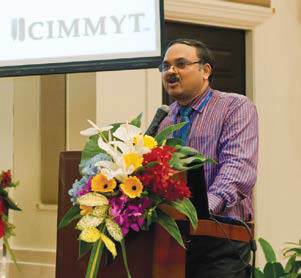 When BM Prasanna, CIMMYT’s global maize program director, opened the 12th Asian Maize Conference and Expert Consultation on “Maize for Food, Feed, Nutrition and Environmental Security” in Bangkok last week he said that boosting maize crops would be a key to food security. In China, maize is the number one crop in acreage, covering 35.26 million hectares (87 million acres) in 2013, an area comparable to that of the United States, Prasanna said. The big questions are whether or not China can increase yields before 2020 to avoid being the largest importer of maize and whether Asia can meet the demand for maize “by shortening, widening and improving the breeding funnel,” Prasanna said.
When BM Prasanna, CIMMYT’s global maize program director, opened the 12th Asian Maize Conference and Expert Consultation on “Maize for Food, Feed, Nutrition and Environmental Security” in Bangkok last week he said that boosting maize crops would be a key to food security. In China, maize is the number one crop in acreage, covering 35.26 million hectares (87 million acres) in 2013, an area comparable to that of the United States, Prasanna said. The big questions are whether or not China can increase yields before 2020 to avoid being the largest importer of maize and whether Asia can meet the demand for maize “by shortening, widening and improving the breeding funnel,” Prasanna said.
He added that efforts are underway to significantly enhance genetic gain per unit over time: CIMMYT and the University of Hohenheim (Stuttgart, Germany) are utilizing doubled haploid technology; other partnerships are focused on genetic diversity and introgressing transgenic traits under humanitarian license through public-private partnerships.
“Strengthening seed systems is also important for breeding programs to make an impact,” Prasanna said. “The sooner farmers, especially smallholders in unreached areas, have access to improved varieties and a complementary agronomic package of practices, the greater the opportunity to increase productivity.”
Challenges are many. Heat stress and drought stress, among others, are an increasing reality in many maize-growing regions in the tropics. Two promising CIMMYT- Asia heat-tolerant commercial hybrids (31Y45 and DKC9108) are currently being marketed in Asia. Scientists also confirm that a strong pipeline of water stress-resilient, Asia-adapted maize hybrids is ready for deployment in rainfed areas of Asia.
Prasanna concluded by reminding the 350 conference participants that “putting women and children at the center of development will help transform their societies.” Quoting Melinda Gates, he said that by ignoring gender inequities, many development projects fail to achieve their objectives.
As he concluded his remarks with a big smile, Prasanna could not resist sharing, “Nothing looks more beautiful to me than maize.”
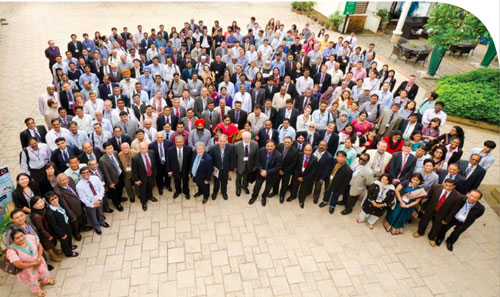
12th Asian Maize Conference
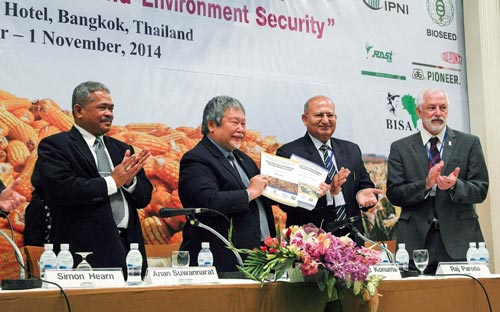
The 12th Asian Maize Conference is taking place in Bangkok from 30 October to 1 November, bringing together more than 350 leading agricultural researchers, policy-makers, farmers and service providers from across the public and private sectors. The conference, “Maize for Food, Feed, Nutrition and Environmental Security,” was organized by the Asia-Pacific Association of Agricultural Research Institutions (APAARI), the International Maize and Wheat Improvement Center (CIMMYT), the Food and Agriculture Organization (FAO) of the United Nations and the Thai Department of Agriculture, and will culminate in 10 major recommendations to set in place a roadmap for a sustainable intensification strategy for maize in Asia.
The objectives of the conference are to assess specific priorities to enhance maize production and productivity in the region, share the latest knowledge on cutting-edge maize technologies and generate awareness among institutions and stakeholders of better uses of maize as food, feed, fodder and as an industrial crop in Asia.
“This forum provides us with a platform to create synergies among institutions and stakeholders, all of whom recognize the enormous value of maize as a food and feed crop,” said guest of honor Anan Suwannarat, Director General of the Thai Department of Agriculture.
The area, production and yield of maize have increased several-fold over the last 50 years; much of that growth has occurred in the developing world. Compared to other cereals, maize has recorded the fastest annual growth in Asia (around 4 percent). The demand for maize in Asia has been growing in response to changing consumer interests and to feed the growing livestock sector.
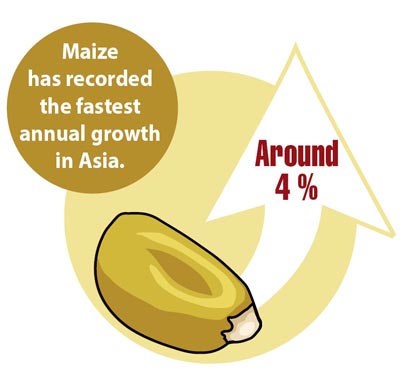 “Among cereals, maize offers immense opportunities to address both food and nutrition security in Asia,” said Dr. Raj Paroda, APAARI executive secretary and conference co-chair. “Exciting scientific achievements in the recent past have led to higher annual growth in maize than all other cereals in the region. We now need to effectively harness the existing potential by out-scaling innovations in maize to have greater impact on the livelihoods of smallholder farmers.”
“Among cereals, maize offers immense opportunities to address both food and nutrition security in Asia,” said Dr. Raj Paroda, APAARI executive secretary and conference co-chair. “Exciting scientific achievements in the recent past have led to higher annual growth in maize than all other cereals in the region. We now need to effectively harness the existing potential by out-scaling innovations in maize to have greater impact on the livelihoods of smallholder farmers.”
At the same time, maize production and productivity in several Asian countries is severely constrained by an array of factors, including lack of access to improved seeds and other critical production-related inputs, lack of training and knowledge transfer for resource-poor farmers, and abiotic and biotic stresses, the magnitude and dynamics of which are rapidly increasing due to climate change. However, there remains great scope to increase the production area of maize in the region, as well as tremendous opportunities for productivity increases and innovations in crop improvement, management and diversification.
According to Dr. Thomas A. Lumpkin, CIMMYT director general and the other conference co-chair, “Sustainably increasing yields and stabilizing prices requires a concerted effort at the policy level, deployment of new technologies and long-term research investments to ensure that Asian farmers are prepared to respond to the enormous challenges facing agriculture.”
Upcoming: 12th Asian Maize Conference
In Asia, maize production is growing at a faster rate than any other cereal. The demand for maize has grown in response to changing consumer habits; with greater demand for meat in consumers’ diets, maize is in high demand as feed for the growing livestock sector. At the same time, there remains great opportunity to increase the area under maize production in the region, as well as tremendous opportunities for innovations in crop improvement, management and diversification.
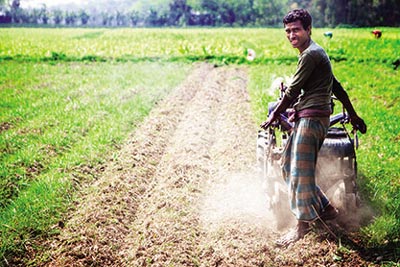
It is in this context that the 12th Asian Maize Conference and Expert Consultation on “Maize for Food, Feed, Nutrition and Environmental Security” will be convened in Bangkok, Thailand, from 30 October to 1 November.
Organized by the Asia-Pacific Association of Agricultural Research Institutions (APAARI), CIMMYT, the FAO Regional Office for Asia and the Pacific, the Thai Department of Agriculture and the CGIAR Research Program on MAIZE (MAIZE CRP), the event will bring together around 250 researchers, policy-makers, service providers, innovative farmers and representatives of various organizations from across the public and private sectors.
The objective of the conference is to assess specific priorities to enhance maize production and productivity in the region, share the latest knowledge on cutting-edge maize technologies and generate awareness among institutions and stakeholders toward the better use of maize as a food, feed and an industrial crop in Asia.
These discussions will lead to an innovative and impact-oriented regional strategy for accelerated adoption of resilient technologies, market opportunities, networks, investment priorities and policy guidelines.
The Third Circular is available on the MAIZE CRP website. Registration forms, also available with the Third Circular, are accepted until 1 October.
New maize and new friendships to beat Thai drought
CIMMYT E-News, vol 5 no. 3, March 2008
CIMMYT fosters regional partnerships and provides seed to help researchers in Thailand get drought resistant maize to farmers.
“We are very, very dry,” says farmer Yupin Ruanpeth. “Last year we had a drought at flowering time and we lost a lot of yield.” In fact, she explains, during the last five years, her family’s farm has suffered from severe drought three times in a row. The soil is good and in a year with no drought they can harvest five tons of maize per hectare, but last year they could only harvest three tons per hectare.
Geographically, the Thai province of Nakhon Sawan lies only a short drive from lush lowland paddy fields, but it seems a world away. In this region the rainy season (between May and September) brings enough water for a single crop, usually of maize or cassava, and in the dry season the fields lie fallow. Almost all maize in Thailand is rainfed, grown under similar conditions
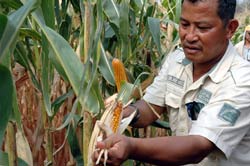 At the Thai Department of Agriculture’s Nakhon Sawan Field Crops Research Center, Pichet Grudloyma, senior maize breeder, shows off the drought screening facilities. Screening is carried out in the dry season, so that water availability can be carefully controlled in two comparison plots: one well-watered and one “drought” plot, where watering is stopped for two weeks before and two weeks after flowering. Many of the experimental lines and varieties being tested this year are here as the result of the Asian Maize Network (AMNET). Funded by the Asian Development Bank, this CIMMYT-led project has brought together scientists from the national maize programs of five South East Asian countries to develop drought tolerant maize varieties and deliver them to farmers.
At the Thai Department of Agriculture’s Nakhon Sawan Field Crops Research Center, Pichet Grudloyma, senior maize breeder, shows off the drought screening facilities. Screening is carried out in the dry season, so that water availability can be carefully controlled in two comparison plots: one well-watered and one “drought” plot, where watering is stopped for two weeks before and two weeks after flowering. Many of the experimental lines and varieties being tested this year are here as the result of the Asian Maize Network (AMNET). Funded by the Asian Development Bank, this CIMMYT-led project has brought together scientists from the national maize programs of five South East Asian countries to develop drought tolerant maize varieties and deliver them to farmers.
AMNET achievements
“We already have two releases under AMNET,” explains Grudloyma. These are varieties produced by the national maize program, focusing prior to AMNET on resistance to the disease downy mildew, which have also proved themselves under drought screening. The first, Nakhon Sawan 2, was released in 2006. The second, experimental hybrid NSX 042029, has been popular in farmer participatory trials and with local seed companies, and is slated for release in 2008. “This is the best hybrid we have,” says Grudloyma with pride. “It’s drought tolerant, disease resistant, and easy to harvest by hand.” The two hybrids incorporate both CIMMYT and Thai breeding materials, a legacy of Thailand’s long relationship with the Center.
In current work under AMNET, the Thai breeders are crossing lines from the national breeding program with new drought tolerant materials provided each year by CIMMYT. “We screen for drought tolerance in the dry season and downy mildew resistance in the rainy season, and take the best materials forward each year,” explains Grudloyma. “We now have many promising hybrids coming though.”
Funding from the project has also had a big impact on the team’s capacity to screen those hybrids. “We had a small one to two hectare facility before; now we have four hectares with a perfect controlled-irrigation system. Because we’ve been in AMNET, we have good varieties and good fieldwork and screening capacity. This is leading to other projects, for example we’re currently working with GCP [the Generation Challenge Program].” Thailand has also taken on a role in seed distribution, receiving and sharing seed from the AMNET member countries, and testing the varieties on the drought screening plots at the Research Center.
Sharing knowledge across borders
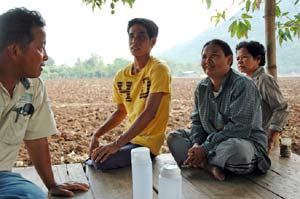 For Grudloyma, this collaborative approach is a big change. “We’ve learned a lot and gained a lot from our friends in different countries. We each have different experiences, and when we share problems we can adapt knowledge from others to our own situations.”
For Grudloyma, this collaborative approach is a big change. “We’ve learned a lot and gained a lot from our friends in different countries. We each have different experiences, and when we share problems we can adapt knowledge from others to our own situations.”
The Thai researchers can come up with many examples of things they have learned from their AMNET partners. “We saw the very friendly relationships between a number of seed companies and the Vietnam team, and we tried to modify the way we worked in Thailand,” says Grudloyma. “This year we shared promising hybrids with seed companies before release. Before that we just worked with farmers and small seed producers, and the seed companies could buy seed after varieties were released.” The result has been wider distribution of new drought tolerant varieties: this year the group received orders for enough parental materials for NSX 042029 to produce 300 tons of seed.
“We learned how to evaluate farmer preferences better from the Philippines team,” adds Amara Traisiri, an entomologist working on responding to these preferences. “We now use their method in all our field trials with farmers and we’re getting a more accurate picture of what farmers want.” This information caused the group to include ease of hand harvest as another trait to consider in their breeding program, after realizing how important it is to farmers. And the learning continued at this month’s annual regional training meeting. “Today, we learned a system for farmer participatory trials,” says Grudloyma, referring to a session on planning and analyzing trial data from CIMMYT maize breeder Gary Atlin. “With these new ideas to direct us we’ll be able to get better results.”
Almost all Thai maize farmers grow improved hybrid varieties, and for Ruanpeth, her priorities are clear. “Drought tolerance is very important”, she says, and dismisses other traits, such as yellow color. “No, I want varieties that are drought tolerant.” She likes to try the latest hybrids and has grown more than 10 commercial varieties. She eagerly accepts the suggestion from Grudloyma’s team to try their new hybrids on a small area this year.
The project has built capacity and relationships that will endure, according to Grudloyma. “Our station is now very good at working with drought,” he says, “and we’ll continue cooperation and providing germplasm. We already have plans for collaboration with China and Vietnam.” CIMMYT’s role in providing germplasm and access to new knowledge and technologies has been vital, as has its leadership. “It’s very hard to get hold of germplasm from anywhere except CIMMYT,” says Grudloyma. “It’s also difficult to come together: we needed an international organization to coordinate and facilitate regional interaction. With CIMMYT everything is easier.”
For more information: Kevin Pixley (k.pixley@cgiar.org)
Corpoica maize ‘V-114’ released in Colombia
Last 25 July, more than 180 farmers and staff from CIMMYT and CORPOICA, Colombia’s agriculture research organization, gathered in the field of Isabel Cristina Cardenas at Los Palmitos, near Sincelejo, Sucre Department, Colombia, to celebrate the release of the new variety V-114. A product of CIMMYT research in Mexico, Thailand, Peru, and Colombia, and with key contributions from Colombian scientists in evaluation and promotion, V-114 was formerly known as Iquitos 9328 and was developed by Hugo Cordova, Carlos De Leon, Luis Narro and other CIMMYT staff, together with CORPOICA. CIMMYTs Asian Regional Maize Program also improved the variety’s resistance to downy mildew, an important disease of maize in this region of Colombia, prior to its introduction. CORPOICA staff at the ceremony included Paolo Bianchi, Director of the organization’s Turipaná Research Station, while CIMMYT was represented by Luis Narro and me.
Farmers at the field day listed for researchers some of their most highly-valued traits in an improved variety. These included low production costs, yields above 3 t/ha, suitability for use under zero-tillage and for intercropping with cassava, resistance to insect pests, and that the seed can be saved and replanted.
When asked about their experience growing V-114, farmers had the following comments:
- V-114 looks like a local variety (criollo) and they think it contains local germplasm because it has variation for kernel color (yellow to reddish) and cob shape. They like this as they associate it with stability and stress tolerance.
- Farmer Rigoberto Romero said that when he planted recycled seed of V-114 he obtained the same (good) performance from the second crop as he obtained in the first season, when he planted official (‘certified’) seed.
- Farmer Silvio Tovar said that he planted 5 kg of seed as an intercrop with cassava, and harvested 1 ton of maize (equivalent to more than 4 t/ha).
The field day was a celebration of several years of work by CIMMYT and CORPOICA scientists, and a couple years of participatory evaluation work with farmers. It was a pleasure to see the excellent interaction between CORPOICA extension staff and farmers, who exchanged sincere questions, important advice, and quite a few jokes. In addition to lunch, each farmer at the field day was given 5 kg of seed of V-114.

